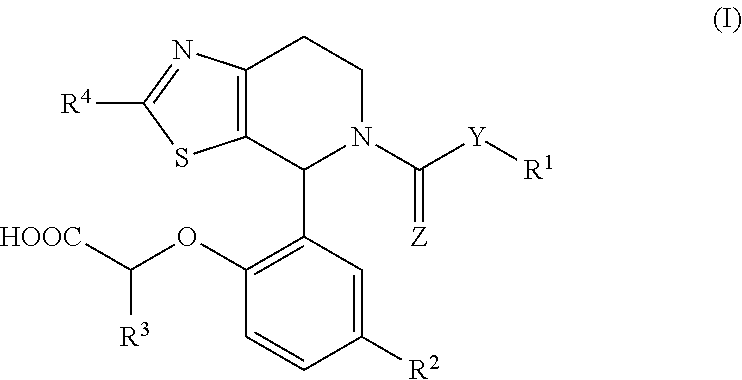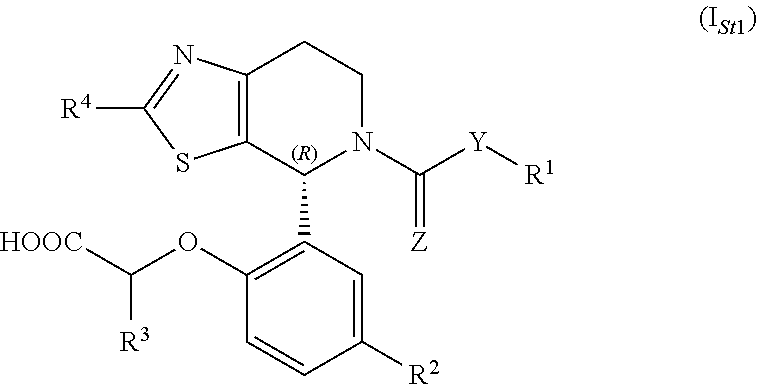1-phenyl-substituted heterocyclyl derivatives and their use as prostaglandin d2 receptor modulators
a technology of prostaglandin d2 receptor and phenyl derivative, which is applied in the direction of biocide, immunological disorders, drug compositions, etc., can solve the problems of limited efficacy of anti-histamines and leukotriene antagonists, and the association of unwanted side effects with long-term use of corticosteroids
- Summary
- Abstract
- Description
- Claims
- Application Information
AI Technical Summary
Benefits of technology
Problems solved by technology
Method used
Image
Examples
example 110
(±)-{4-Chloro-2-[5-(2-methoxy-benzylthiocarbamoyl)-4,5,6,7-tetrahydro-thiazolo[5,4-c]pyridin-4-yl]-phenoxy}-acetic acid (C23H22N3O4ClS2, MW=503.07)
[0340]To a solution of (±)-[4-chloro-2-(4,5,6,7-tetrahydro-thiazolo[5,4-c]pyridin-4-yl)-phenoxy]-acetic acid ethyl ester hydrochloride (50 mg, 0.13 mmol, 1.00 eq.) and NEt3 (54 μL, 0.39 mmol, 3.00 eq.) in MeCN (1 mL), 2-methoxybenzyl isothiocyanate (24 mg, 0.14 mmol, 1.05 eq.) in MeCN (1 mL) was added. The mixture was stirred at r.t. for 18 hours. 1M aq. NaOH (0.5 mL) was added. The mixture was stirred at r.t. for 18 hours. The solution was neutralized with formic acid, purified by prep. HPLC (column: Atlantis, 30×75 mm, 10 um, UV / MS, acidic conditions), and concentrated in vacuo to give the desired acid as a white solid.
[0341]LC-MS 1FA: tR=0.95 min; [M+H]+=504.2
example 111
(±)-4-(2-Carboxymethoxy-5-chloro-phenyl)-2-propyl-6,7-dihydro-4H-thiazolo[5,4-c]pyridine-5-carboxylic acid benzyl ester (C25H25N2O5ClS, MW=500.12)
[0342]To a solution under N2 of (±)-2-bromo-4-(5-chloro-2-ethoxycarbonylmethoxy-phenyl)-6,7-dihydro-4H-thiazolo[5,4-c]pyridine-5-carboxylic acid benzyl ester (50 mg, 0.09 mmol, 1.00 eq.) and 0.5M propylzinc bromide in THF (0.36 mL, 0.18 mmol, 2.00 eq.) in THF (10 mL), tetrakis(triphenylphosphine) palladium (0) (5.1 mg, 4 μmol, 0.05 eq) was added. The mixture was stirred at 50° C. for 18 hours. The mixture was allowed to cool to r.t. and concentrated in vacuo. The residue was taken up in DMF, filtered, and purified by prep. HPLC (column: Atlantis, 30×75 mm, 10 um, UV / MS, acidic conditions) and concentrated in vacuo. The resulting ester was dissolved in DMF (0.5 mL), 1M aq. NaOH soln. (0.5 mL) was added. The resulting solution was stirred at r.t. for 18 hours. The solution was neutralized with formic acid (1 mL), filtered, and then purified ...
example 112
(±)-4-(2-Carboxymethoxy-5-chloro-phenyl)-2-phenyl-6,7-dihydro-4H-thiazolo[5,4-c]pyridine-5-carboxylic acid benzyl ester (C28H23N2O5ClS, MW=534.10)
[0344]To a mixture under N2 of (±)-2-bromo-4-(5-chloro-2-ethoxycarbonylmethoxy-phenyl)-6,7-dihydro-4H-thiazolo[5,4-c]pyridine-5-carboxylic acid benzyl ester (63 mg, 0.12 mmol, 1.00 eq.), phenylboronic acid (15 mg, 0.12 mmol, 1.00 eq.) and sodium carbonate (50 mg, 0.47 mmol, 4.00 eq.) in toluene / MeOH / Water 20:4:1 (4 mL), tetrakis(triphenylphosphine) palladium (0) (6.8 mg, 6 μmol, 0.05 eq.) was added and the mixture was stirred at 100° C. for 18 hours. The mixture was allowed to cool to r.t. and concentrated in vacuo. The residue was partitioned between AcOEt (25 mL) and water (25 mL). The layers were separated. The org. phase was washed with sat. aq. NaCl soln. (1×12 mL), dried over MgSO4 and filtered through Celite. The filtrate was concentrated in vacuo. The residue was dissolved in DMF (0.5 mL), 1M aq. NaOH soln. (0.5 mL) was added. The ...
PUM
 Login to View More
Login to View More Abstract
Description
Claims
Application Information
 Login to View More
Login to View More - R&D
- Intellectual Property
- Life Sciences
- Materials
- Tech Scout
- Unparalleled Data Quality
- Higher Quality Content
- 60% Fewer Hallucinations
Browse by: Latest US Patents, China's latest patents, Technical Efficacy Thesaurus, Application Domain, Technology Topic, Popular Technical Reports.
© 2025 PatSnap. All rights reserved.Legal|Privacy policy|Modern Slavery Act Transparency Statement|Sitemap|About US| Contact US: help@patsnap.com



